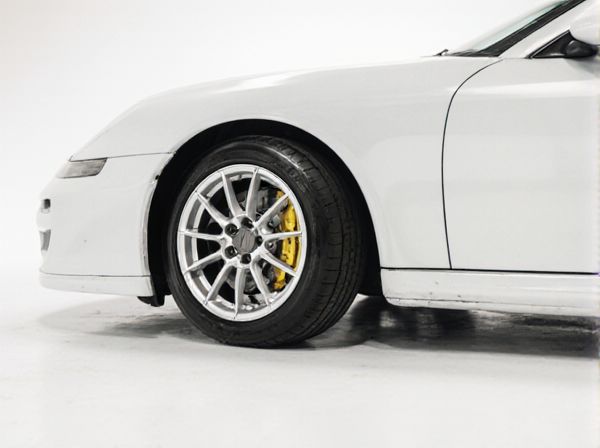
Photo illustration: Three-piece vs One-piece Wheel
A three-piece wheel offers customization with separate components for the rim, center, and barrel, allowing for tailored fitment and repairs. One-piece wheels provide a solid structure, enhancing strength and usually lowering weight due to their single construction. Your choice depends on preferences for flexibility, performance, and maintenance.
Table of Comparison
| Feature | Three-piece Wheel | One-piece Wheel |
|---|---|---|
| Construction | Separate rim, center, and outer lip bolted together | Single solid piece forged or cast |
| Customization | Highly customizable in size, offset, and style | Limited customization, fixed design |
| Weight | Generally heavier due to multiple parts | Lighter due to single-piece structure |
| Repairability | Easier to repair or replace specific sections | Difficult to repair; often requires full replacement |
| Cost | More expensive due to complexity and materials | More affordable and widely available |
| Strength | Strong but can be less rigid depending on assembly | High strength and rigidity |
| Use Case | Performance cars, custom builds, and racing | Daily drivers and standard vehicles |
Introduction to Wheel Construction
Three-piece wheels consist of three separate components: the center, outer barrel, and inner barrel, offering enhanced customization and repair options. One-piece wheels are forged or cast as a single unit, providing superior strength and often lighter weight due to integrated construction. The choice between these designs impacts performance, durability, and aesthetic flexibility in automotive applications.
What Are One-Piece Wheels?
One-piece wheels are manufactured from a single solid piece of metal, typically aluminum alloy, which offers a lightweight and strong structure ideal for performance and durability. These wheels provide a uniform design with fewer weak points compared to multi-piece wheels, enhancing stability and reducing the risk of leaks or structural failures. Widely used in both stock and aftermarket applications, one-piece wheels simplify maintenance and offer a cost-effective solution for everyday and racing vehicles.
What Are Three-Piece Wheels?
Three-piece wheels consist of three separate components: the center, outer barrel, and inner barrel, bolted together to form a single wheel. This design allows for customization of wheel width, offset, and finish, making them highly adaptable for performance and aesthetic preferences. Their modular construction also facilitates easier repairs and replacements compared to one-piece wheels.
Manufacturing Process Comparison
Three-piece wheels consist of separate rim, outer lip, and center components bolted together, requiring precise machining and assembly to ensure structural integrity and customization flexibility. One-piece wheels are forged or cast as a single unit, streamlining the manufacturing process with fewer machining steps and enhanced uniform strength. The multi-step assembly of three-piece wheels allows for tailored sizing and repair options, whereas one-piece wheels prioritize manufacturing efficiency and overall durability.
Strength and Durability Differences
Three-piece wheels consist of separate rim, center, and lip components bolted together, allowing for easier repairs and customization but slightly lower overall strength compared to one-piece wheels. One-piece wheels are forged or cast as a single unit, providing superior structural integrity and enhanced durability under high stress conditions. The solid construction of one-piece wheels typically offers better resistance to impacts and fatigue, making them ideal for performance and heavy-duty applications.
Weight and Performance Analysis
Three-piece wheels offer customizable weight reduction through separate components made from lightweight alloys, resulting in improved acceleration and handling compared to one-piece wheels. One-piece wheels are typically heavier due to their single forged or cast construction, but provide greater structural integrity and durability under high-performance conditions. Choosing between the two depends on balancing weight savings for enhanced performance against the need for strength and ease of repair.
Customization Options Explained
Three-piece wheels offer extensive customization options, allowing users to select different materials for the center, outer rim, and inner rim, enabling tailored weight, strength, and aesthetic preferences. One-piece wheels, while generally more cost-effective and structurally rigid, provide limited customization since they are manufactured as a single entity. The modular nature of three-piece wheels allows for easier repairs and the ability to mix and match finishes, bolt patterns, and offsets, catering to high-performance and luxury vehicle needs.
Price Comparison: Three-piece vs One-piece
Three-piece wheels typically cost more than one-piece wheels due to their modular design and higher manufacturing complexity, allowing customization of rim width and offset. One-piece wheels are generally more affordable, offering a cost-effective solution with simpler construction and fewer components. The price difference reflects the trade-off between customization flexibility in three-piece wheels and the budget-friendly, durable design of one-piece wheels.
Maintenance and Repair Considerations
Three-piece wheels offer easier maintenance and repair due to their modular design, allowing damaged parts like rims or centers to be replaced individually, which reduces overall costs. One-piece wheels, being a single solid unit, require full replacement if damaged, making repairs more expensive and less flexible. The bolt-on construction of three-piece wheels also facilitates customization and regular upkeep without the need for specialized equipment.
Choosing the Right Wheel for Your Needs
Choosing the right wheel depends on factors like durability, customization, and budget. Three-piece wheels offer better customization with replaceable components and easier repairs, making them ideal for performance enthusiasts and those seeking unique designs. One-piece wheels provide superior strength and lower weight at a usually lower cost, making them suitable for everyday driving and track use where reliability is paramount.
 caratoz.com
caratoz.com